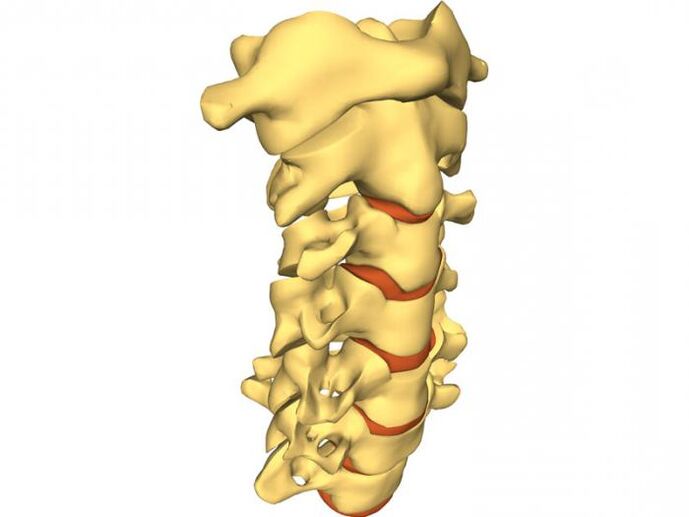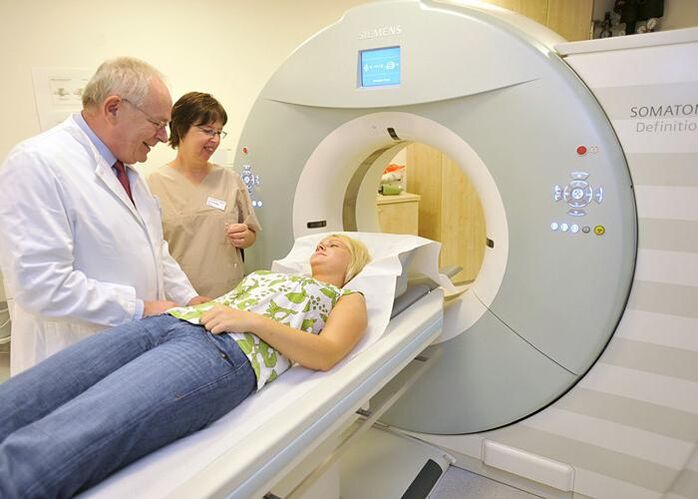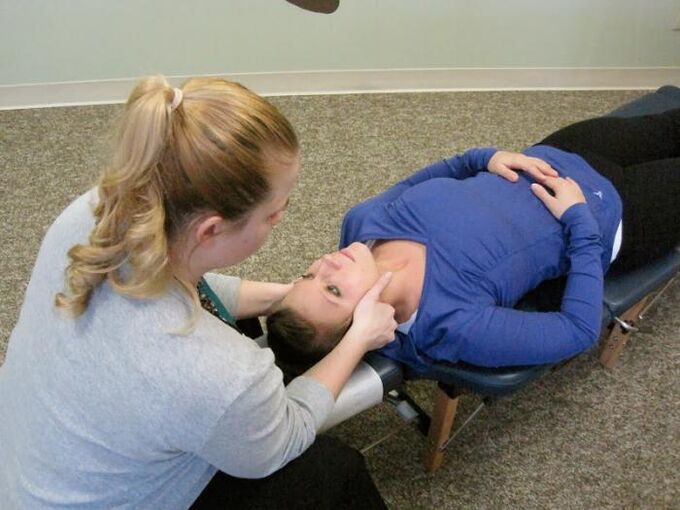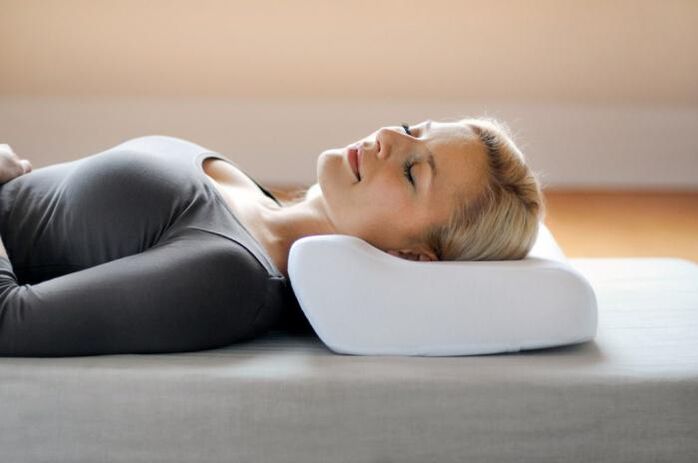Characteristics of the disease
Osteochondrosis is generally a degenerative modification of the intervertebral discs, which further affects bone tissue and the nervous system. What happens to this disease? In a cartilaginous disc that has a cushioning function in the structure of the spinal column, dehydration, or simply dehydration, begins due to metabolic insufficiency. The nucleus begins to grasp the ring around it and the disc extends beyond the back of the malleolus. This phenomenon is called protrusion. If the membrane is ruptured, then an intervertebral hernia appears, which is even more dangerous.

Osteochondrosis of the cervical spine is a disease that brings a lot of pain and discomfort in a person’s life. Unlike the thoracic and lumbar vertebrae, the cervical spines are more mobile, they are the smallest and are constantly exposed to stress. The disease most often affects these specific segments of the spine. A large number of nerve and blood branches are concentrated in the cervical spine. Here passes an important large vertebral artery that carries nutrients to the brain. The compression state of this vessel is dangerous with the development of spinal or cerebral ischemia as well as stroke. If these arteries and nerve fibers affect the cervical spine, then the person loses precise coordination of movements, impaired hearing and vision, frequent dizziness and various neurological disorders, which will be discussed below.
Reasons
Osteochondrosis of the cervical spine occurs even at a young age. What causes the disease? What causes the onset of the disease, even in people under 30 years of age? Osteochondrosis of the cervix, which requires a lot of time and patience to treat, is due to two main factors:- Hypodynamics, or sedentary lifestyle;
- Wrong nutrition.
As a result, there is a disturbance of metabolism (metabolism) throughout the body, especially in bone and cartilage tissues, the level of salt in the blood rises and they, unable to find a solution in the blood, "shelter" in the tissues of the kidneys, liver and cervical spine. An unbalanced diet leads to a lack of nutrients in the cartilage, resulting in abnormal changes in the intervertebral discs. Osteochondrosis is particularly susceptible to people at risk.

Name the factors that increase the likelihood of developing the disease:
- Inheritance;
- age after 40 years;
- Excess weight;
- Frequent hypothermia (do not lie to say "Do not catch a cold on the neck! ");
- endocrine system dysfunction, metabolic disorders;
- Spinal cord injuries;
- systemic lupus erythematosus;
- rheumatism;
- Nature of activity - drivers, office workers, cashiers, athletes, people engaged in heavy physical labor.

Symptoms
How is cervical osteochondrosis detected? The symptoms of the disease and the nature of the pain depend on which segments are damaged. The following states may develop in this regard:
- vertebral artery syndrome;
- hypertensive syndrome;
- Radical Syndrome;
- Cervical migraine syndrome.
Let's get to know each of them. With vertebral artery syndrome, acute headaches appear at an early stage. The person often has dizziness, gait, and decreased visual acuity. His sudden movement can lead to loss of consciousness. Radical syndrome is characterized by a variety of manifestations. ენიYour include:
- cervicalgia, or severe neck pain;
- convulsion when changing head;
- weakness and tinnitus;
- numbness and pain in the arm;
- Impaired auditory and visual functions;
- tinnitus;
- cervicobrachialgia, or pain that extends from the neck to the arms;
- Feeling of swelling and numbness of the tongue.
Cervical migraine syndrome is characterized mainly by a decrease in blood flow to the brain tissue, which leads to hypertension and the development of symptoms such as noise and ringing in the ears, their swelling, dizziness, pulse. The danger of this condition is the possibility of developing a spinal stroke. Hypertensive syndrome is accompanied by headache, intensified head movements, nausea and vomiting (especially in the morning), nervousness, sudden changes in blood pressure, the appearance of dark circles under the eyes, light headaches.

develops cerebral hypoxia (oxygen starvation). Cervical osteochondrosis is often manifested by cardiac arrhythmia, in which a monotonous heart rhythm is lost. Vegetative-vascular dystonia develops due to tingling of the lateral vertebral arteries.
Diagnostics
The first step in diagnosing cervical osteochondrosis is to examine the patient. The neurologist visually examines the condition of the spinal column, spinal muscles, and posture, and probes the presence of rash spinal processes with a probe. On palpation, the doctor will be able to understand which parts of the pain are affected by the patient's reaction. Hardware diagnostic methods are used:
- radiography;
- computed tomography;
- magnetic resonance imaging;
- Dopplerography.
The first method often involves the introduction of a contrast agent into a specific tissue (discography, angiography, etc. ). This is necessary to get more accurate information about the peculiarities of the disease course.

Treatment
Your doctor will tell you how to treat cervical osteochondrosis without damaging the body. The following are basic rules and recommendations for treating this nasty disease, but a visit to a neurologist is the beginning of successful treatment. Treatment of cervical osteochondrosis is carried out using a number of methods. Including:
- drug therapy;
- physiotherapy;
- Traditional medicine;
- Exercises.
Drug therapy
How to treat cervical osteochondrosis with medication? Drug therapy for the disease includes the following remedies:
- pain medications;
- anti-inflammatory;
- vitamins;
- Chondroprotectors.
Analgesics help relieve pain during exacerbation of cervical osteochondrosis and are used for a short time. The attending physician may prescribe the drugs tramadol, tolperisone hydrochloride, and etoricoxib as anesthetics. In case of very strong pain it is possible to use lidocaine injections.

Nonsteroidal anti-inflammatory drugs are intended to reduce inflammation, including medications such as diclofenac, ibuprofen, piroxicam. Such funds are also used externally. These are different ointments and gels: "Diclofenac" and so on. Sh. The most valuable vitamins in terms of maintenance therapy for osteochondrosis are B group vitamins, which can reduce tissue sensitivity and weaken the neurological manifestations of the disease.
Chondroprotectors
They are formulated by pharmacologists to repair cartilage. There are two active ingredients that make up such drugs - glucosamine and chondroitin. Both compounds can be included in a single preparation or used separately. Examples of chondroprotectors: glucosamine patches, chondroitin sulfate ointment, etc. Sh.
blockade
In case of severe pain, injections of the drug directly at the site of injury help to alleviate the patient's condition. This injection is called a blockade. A mixture of medicines is usually used as a medicine. One of them has an analgesic effect, the other is aimed at relieving inflammation. The blockade can only be done by a highly qualified doctor, by no means do this procedure yourself! This can not only harm the patient's health, but also endanger his or her life. This injection is done in two ways:
- injection of the drug into the ligaments and tissues surrounding the joint;
- injection directly into the intervertebral disc.
Physiotherapy
Physiotherapy procedures are very effective in cervical osteochondrosis. They accelerate recovery, acting beneficially on the whole body. Before we talk about them, we have listed the contraindications to physiotherapy:
- tumors, oncological diseases;
- blood diseases;
- Acute dermatological diseases;
- Taking medications that can increase the effect of physiotherapy.
How to treat cervical osteochondrosis using physiotherapy? In this respect, the use of many methods has a good effect. For example, shock wave therapy is the use of acoustic waves on an injury. It reduces inflammation, swelling, pain, stimulates collagen synthesis and improves tissue metabolism. Also used laser therapy, magnetotherapy, ultrasound treatment, vibration therapy. Exposure to a painful site with low-voltage pulsed currents, or diadynamic therapy, reduces pain intensity. Electrophoresis with the drug "Procaine" gives an analgesic effect during exacerbation. Additional physiotherapy methods include ultraviolet irradiation of the affected area and spinal traction, or densor therapy.
Physiotherapy exercises
Cervical Osteochondrosis Exercise Tool allows you to achieve tangible results. It is important that it is used only in the last stage of treatment, since active movements around the neck are strictly forbidden in the first and intermediate stages. The gymnastics is performed with a cotton collar, which is performed in the cervical region. Resistant exercises are performed with the help of a doctor who tries to bend the patient with his palms and he, in turn, tries to overcome the action of the doctor. This strengthens the muscular corset of the neck. Self-justification exercise is also helpful. This is the following. The patient lying on the couch raises himself and holds him in this position for 5 seconds. This time increases to 40-60 seconds if the pain and neurological syndrome have already been overcome. Therapeutic gymnastics involves performing each exercise no more than 5 times in one approach.
For cervical osteochondrosis gymnastics is designed for the following:
- Improves blood supply to the affected area;
- to strengthen the muscles of the back and neck;
- Reduce the load on the spine;
- normalize joint mobility;
- Accelerate glucose metabolism for active nutrition of intervertebral discs.

In diseases such as cervical osteochondrosis, massage is needed. It deals with the methods of manual therapy and aims to relax the muscles, improve blood circulation and lymph movement at the site of injury.
Traditional medicine
Treatment of diseases such as cervical osteochondrosis, folk remedies are considered as an adjunct and by no means the main therapy. The number of recipes using different herbs and products is very large. They are widely used in products such as lemon, garlic, barberry or chicken leaves (as a compress), dandelion root, St. John's wort, tier, lavender and many more. The patient is responsible for his own health when using traditional medicine.

Nutritional properties
How is cervical osteochondrosis cured? This question is asked by many. But how to eat with this disease, which food is useful? Let’s list them:
- Dairy products;
- lean meats and fish;
- jelly meat;
- marmalade;
- jelly;
- fresh fruits and vegetables;
- Sources of B vitamins - liver, nuts, brown rice, broccoli, buckwheat, brewer's yeast, green vegetables, kidneys;
- complex carbohydrates - whole grain breads, cereals, vegetables;
- Vegetable fats - olive, sunflower, flaxseed oil.
Do not forget about products that can be harmful in the treatment of osteochondrosis. Do not use excessive amounts of sweets, baked goods, alcohol, smoked meats and salty foods, spicy foods, animal fats, coffee and strong tea. Remove sugar, potatoes and white bread from the menu.
Prevention
Do not neglect your morning exercises, as well as neck stretching during your work day. It helps to improve blood circulation, thus ensuring the supply of nutrients to the cartilage tissue and the relaxation of the muscles. Get More Exercise - Regular jogging and fitness classes are an important part of preventing osteochondrosis. Excess weight often provokes the development of the disease, so try to follow the arrow on the scales. Do not overeat, do not eat high-calorie foods, fatty and sugary foods. Eliminate all chronic infections in your body. Particular attention should be paid to the correct position of the body during sleep and rest - the neck muscles should not be stretched.

For example, all patients should have an orthopedic pillow for cervical osteochondrosis and its use is also beneficial for disease prevention. Resting on it relaxes the neck muscles and the blood vessels do not experience strong pressure.
Cartilage Health and Diet
I would like to mention separately that girls and women have different diets, which are sometimes so cruel and low-calorie that the body begins to use the energy source of its own tissues. Remember that any diet should be balanced, contain the minimum necessary nutrients, primarily proteins, and should be accompanied by intake of vitamins and minerals. Otherwise, you risk not only the owner of the faded cartilage, which is very difficult and expensive to restore in the future, but also a number of unpleasant diseases. And remember that the treatment of cervical osteochondrosis will be successful only if the patient follows all the recommendations and prescriptions of the attending physician.































